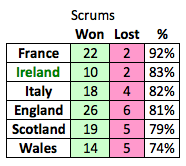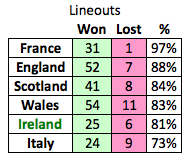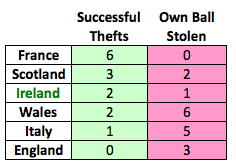The Set Piece – French Magnificence
The structure of the game of rugby union still depends in a large amount on the set piece, i.e. scrums and lineouts.
In order to provide a few possible pointers as to how the 2013 Six Nations might go, here’s a quick look at how each team went in this department in the Autumn Internationals.
Scrums
French Dominance
France were the best team by far at scrum time winning 91% of their scrums. Part of this success rate was due to their discipline as the French conceded precisely zero penalties or free kicks at the scrummage during their three tests. In contrast, Wales, Scotland, Italy and England all each conceded three free kicks on their own scrum.
What did teams do with the ball?
Italy’s Sergio Parisse, unsurprisingly, got his hands on the ball quite a lot from the back of the scrum. In fact, he passed it twice as much as his own scrum halves.
The French scrum halves didn’t run or kick once, passing the ball away from the base of the scrum every time. Ireland took this one step further, with neither scrum half nor number eight doing anything but pass.
In contrast, the England scrum halves’ union might be having a word with coach Stuart Lancaster. In four games, only one pass from the base of the scrum was provided a man wearing a number nine shirt. Instead the number eight took a pass or pickup nine times.
Lineouts
More French Dominance
France again led the way at lineout time, winning a magnificent 31 out of their 32 lineouts. Their only misfire on their own ball was a Dimitri Szarzewski throw-in that didn’t go the required five metres. Benjamin Kayser and Szarzewski had throw success rates of 100% and 93% respectively, a stunning performance.
Careless
Italy were the opposite to the French in losing 9 lineouts through handling errors, crooked throws and having five balls stolen by the defending team. Sergio Parisse’s men suffered the most damage on their own throw between the half way line and the opposition 22, losing 7 of their 15 lineouts in that area of the field. Losing that amount of primary possession obviously makes it difficult to establish a strong position in any game.
Phil Taylor, look away now
Scotland’s Ross Ford is a man who will presumably have spent some time practicing his darts. Of his 22 lineouts he hit just 15, compared to his rival Scott Lawson who missed just 2 of 18. No other country had such a disparity between the performances of their two foremost hookers.
Thievery
Not only were the French the best at keeping their own lineout ball secure, they were also by far the best at stealing opposition ball. Six opposition throw-ins found themselves in French hands, a rate of thievery unmatched by anybody else. The Scots came second, robbing three while having two of their own stolen, while the Irish came third by stealing two and having one stolen from their own throw.
Wales, Italy and England have some work to do with each losing far more stolen ball than they managed to steal themselves.
Keep it simple and stuff it up the jumper
Ireland’s lineout tactic was fairly straightforward – throw it to the middle, catch it and set up a drive with the catcher, usually Peter O’Mahony or Donnacha Ryan, either taking the ball directly into contact themselves or setting up a maul. This constituted fully 65% of what Ireland did with their lineout wins.
Ireland were the only Six Nations team not to bother with both the quick throw (France led the way with six) and the throw over the tail (Scotland had three). Ireland were also the only team to not take a single ball off the top from a lineout; Wales did so 11 times.
Numbers
With a lineout in their own 22, standard operating procedure for all teams was to shorten the lineout to four or five men in their own 22, placing defenders across the field. The opposite was also the case where teams used six and seven lineouts when they got into the opposition 22. Wales of course took this one step further, using the Warren Gatland Thirteen Man Special against the All Blacks.
The Shuffle
Wales’ lineout stats make for interesting reading, especially when viewed beside those of their most northern Celtic neighbours. Not one Welsh forward claimed more than seven takes jumping at a single position; compare this to Alastair Kellock who took 17 clean wins as middle jumper for Scotland. This, despite Wales having 54 lineout wins compared to Scotland’s 40.
Summary
In the Autumn, the French set piece was extraordinarily efficient in securing a total of 95% possession from their own ball and robbing a healthy amount of the opponents’ ball for themselves. This was a higher percentage than any team managed over either the 2012 Six Nations or the Rugby Championship. If the French pack can keep this up they’ll guarantee a massive amount of ball for their half-backs Parra and Michalak to direct play.
In contrast, one would think the Italians can only but improve. In their 76% success rate on set pieces they gave away a quarter of their own ball. Their failure mirrored the French success as that 76% rate was lower than any team in the 2012 Six Nations or Rugby Championships.
Ireland? Well the only 2012 rate that was close to the Italians’ Autumn wastefulness was Ireland’s very poor 79% success rate in last year’s Six Nations. While the Irish pack improved this very slightly to 81% in the Autumn, they will need another big step forward if Ireland’s backs are to be provided with the type of solid forward platform they’ll need to continue the good work started against Argentina.
N.B. All statistics provided by the good people at Opta.



